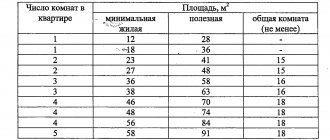The GZHN body refuses to make changes to the register of licenses at the request of the management organization for various reasons, which are then often disputed in court. We are talking about a case that reached the Supreme Court of the Russian Federation, in which the question was considered whether the State Housing Inspectorate was right in considering a two-apartment building to be residential and not multi-apartment.
Why did the RF Armed Forces invalidate some requirements No. 938/pr
1220510
The house has two or more apartments with separate exits
Case No. A70-15067/2019 reached the Supreme Court of the Russian Federation, and the main issue that was considered in all instances was determining the status of the house - whether it was multi-apartment or individual residential.
It started with the fact that in Tyumen the administration held an open competition to select a management organization for a building in which there are only two apartments. The management company that won the competition submitted an application and a package of documents to the GZHN body to include the house in the register of regional licenses: copies of the selection protocol and the management agreement with the owners.
Based on the results of consideration of the application, the State Housing Inspectorate refused the company to make changes to the register, citing paragraphs. “a” clause 5 of order No. 938/pr: The MA did not indicate the address of the apartment building in the application, did not attach a copy of the competitive selection protocol and the management agreement. GZHI noted that all the data in the documents does not relate to apartment buildings, but to a residential building, since the apartments, according to the technical documentation, do not have access to common areas, but have separate entrances. The building cannot be classified as an apartment building.
The managing organization did not agree with this position of the GZHI and filed a lawsuit demanding that the department’s refusal be declared illegal and oblige the GZHI to make changes to the register of licenses.
Housewarming with a creak
A year after the flood in the Irkutsk region, the first three apartment buildings for people who lost their homes were put into operation. 66 families of Tulun received the keys to apartments in the Ugolshchikov microdistrict - this city, like Nizhneudinsk, was hit hardest by the disaster. Then two waves of floods hit the region: about 11 thousand residential buildings were flooded, over 45 thousand people were injured. The list of dead includes 25 people. According to the Ministry of Construction, damage due to the loss of real estate amounted to 10.8 billion rubles.
Footage of flooded houses spread throughout the country - the president flew to the Irkutsk region several times to personally monitor the progress of restoration work after the flood.
House number 1
A house carried away by floods in the city of Tulun in the Irkutsk region. July 1, 2020
Photo: RIA Novosti/Kirill Shipitsin
However, through the winter, due to local bureaucracy, many residents remained in their water-damaged homes. As REN TV journalists said, officials looked at the mold, water in the underground, cracks and monotonously repeated: “Everything is in order.” But in some settlements, activists found out, “their own people” received housing certificates.
Don’t buy, it’ll kill you: officials will be required to report houses in disrepair
The Ministry of Construction and the State Duma supported the rules on entering dilapidated real estate into Rosreestr
“They did a false examination. “We have already purchased housing in the city of Irkutsk and left the populated areas,” noted Sergei Apanovich, co-chairman of the regional headquarters of the ONF in the Irkutsk region. “And there the water didn’t even come to this street.”
If there was an inspection, it went like this: an interdepartmental commission of four people walked around the house in a circle, photographed the damage, then the same had to be done inside the house. The inspectors reported their findings to the council and together decided what to do in a particular case: “leave flood victims alone with their problems, pay for major repairs or provide them with a certificate for new housing.” At the same time, residents complained that the inspection report was sometimes not handed out. Moreover, often the commission had to wait not even weeks - months!
“This inspection should be the third or fourth, but for some it is the first in four months since the flood,” REN TV journalists noted during one of the inspections.
House 2
Flooded houses in the city of Tulun in the Irkutsk region. July 1, 2019
Photo: RIA Novosti/Kirill Shipitsin
Some then abandoned their crumbling, flooded home and moved in with their relatives, while others stayed, huddling in sheds, summer kitchens, and bathhouses. A resident of the village of Shitkino waited several months for money for major repairs - officials periodically lost her application. And a resident of Arshan, who has five adopted children, twice wrote a statement asking for an inspection of her house - a flood washed away a bathhouse and a gazebo from her property, and the fireplace in the house fell under the floor. But local officials replied that there was “no” statement. This attitude towards people was noticed in Moscow as well.
Equal score: they want to speed up the resettlement of emergency housing
The Ministry of Construction proposed to redistribute half a trillion rubles planned until 2024
“I had to create a page on Instagram so that people could contact me. I see that people are not satisfied with the terms for issuing certificates and payment terms. We are dragging this topic out; we should have done this before winter. I don’t understand what’s happening, some kind of sabotage,” said Vitaly Mutko, who at that time held the post of Deputy Chairman of the Russian Government for Construction and Regional Development, indignant.
The apartments have exits to common areas or to the common plot of land where the house is located
The decisive factor in the case was the decision of the court of first instance, which was upheld in the courts of appeal and cassation, and was also confirmed by the Supreme Court of the Russian Federation. It was based on the following legislation:
- A residential building is an individually defined building consisting of rooms, as well as premises for auxiliary use (Part 2 of Article 16 of the Housing Code of the Russian Federation).
- An apartment building is a collection of two or more apartments that have independent exits either to a land plot adjacent to a residential building or to common areas (clause 6 of the Decree of the Government of the Russian Federation dated January 28, 2006 No. 47). Also, the MKD must contain elements of the common property of apartment owners.
- Elements of public property in an apartment building include, among other things, the land plot on which it is located (clause 4, part 1, article 36 of the Housing Code of the Russian Federation).
The court took into account that the disputed object is located on a land plot with a single cadastral number. The site is intended for an apartment building. The inspection report of the building indicates the presence of two apartments. Consequently, this is an apartment building, and not an individual residential building, and the administration had the legal right to hold an open competition, and the management company had the legal right to participate in it and conclude a management agreement with the owners. The judge granted the company's claim.
Does GZHI need a copy of the signed DU to change the register of licenses?
22942
How apartments are given to tenants when a house is demolished
Of these, 5 court decisions were appealed, of which 3 decisions were canceled, 2 were left unchanged.
On the provision of residential premises to replace those recognized as unfit for habitation. Decision of January 24, 2011 No.
If, after the expiration, no response is received, then he has the right to complain about inaction to the district prosecutor's office or court.
For 10 years, my husband and I lived in an apartment that was declared unfit for habitation by an interdepartmental commission and the house was subject to demolition. In August 2020, we divorced, but continued to live in the same apartment, since we do not have the opportunity to separate.
Apartment owners have common property
GZHI filed an appeal, pointing out that the land plot, although it belongs to the common property of the apartment building, is not a common premises. Therefore, the presence of such a plot cannot be a sign that the house is an apartment building. A residential building consisting of two apartments with separate exits to a land plot without direct access to common areas is not multi-apartment. The disputed house has the characteristics of a residential building of a blocked development in accordance with Art. 49 Civil Code of the Russian Federation.
The Court of Appeal, repeating the arguments of its colleagues and fully agreeing with them, also added that
- The disputed building is recognized as an apartment building due to the presence of common property in it: a single roof and a single solid facade, a common foundation, one plot of land, and intra-building utilities for energy supply.
- The presence of common property entails the possibility of managing it by a specialized organization.
- The technical passport of the house indicates the presence of attic floors; accordingly, the house has an attic, which is a room intended to serve more than one apartment, and is part of the common property of the owners of the premises.
The Court of Appeal confirmed the legality of recognizing the building as an apartment building and, therefore, the illegality of the refusal of the State Housing Authority to make changes to the register of licenses according to the application of the management organization. The dispute moved to the cassation court, which completely agreed with the previous decisions. The Supreme Court of the Russian Federation, to which the State Housing Inspectorate appealed, refused to consider the complaint, having found no grounds for this.
As a result, the house was recognized as an apartment building, and the State Housing Authority was obliged to make changes to the register of licenses of the region in accordance with the results of an open competition for the selection of management entities.
On the extension of the contract with the management company, concluded based on the results of an open competition
20781
The procedure for recognizing residential premises as unfit for habitation.
1. This Regulation establishes the procedure for recognizing residential buildings (residential premises) as unsuitable for habitation, regardless of the form of ownership in the housing stock, with the exception of individual residential buildings that are privately owned by persons permanently residing in these residential buildings, as well as recognition of residential buildings (residential premises) as unsuitable for residence of a particular citizen for medical reasons.
2. Residential buildings (residential premises) are considered unsuitable for living:
a) in dilapidated condition;
b) in disrepair;
c) in which the harmful effects of environmental factors have been identified.
3. The criteria and technical conditions for classifying residential buildings (residential premises) as dilapidated or in disrepair are approved by the State Committee of the Russian Federation for Construction and Housing and Communal Services.
The criteria for classifying residential buildings (residential premises) as unsuitable for habitation due to the harmful effects of environmental factors are provided for by state sanitary and epidemiological rules and regulations.
4. Issues regarding the recognition of residential buildings (residential premises) as unsuitable for habitation are resolved by an interdepartmental commission created by the executive authorities of the constituent entities of the Russian Federation (hereinafter referred to as the commission), which, taking into account the regional characteristics of the location of municipalities (territorial disunity, population density, state of the housing stock , other factors) and, in agreement with local governments, can create commissions operating in the territory of one or more municipalities.
5. The commission includes representatives of the executive body of the constituent entity of the Russian Federation and (if necessary) local government bodies, state housing inspection bodies, architecture and urban planning, state sanitary and epidemiological service, state fire service, bodies exercising federal supervision in the field of industrial safety , technical inventory organizations and other bodies and organizations.
The owner of the housing stock or the owner’s representative, performing the functions of managing the housing stock, in relation to the residential building (residential premises) of which the issue of recognizing it as unfit for habitation (hereinafter referred to as the owner’s representative) is invited to participate in the work of the commission (hereinafter referred to as the owner’s authorized representative), and, if necessary, representatives of design and survey organizations that inspected this residential building (residential premises).
6. The commission considers the issue of declaring a residential building (residential premises) unfit for habitation on the basis of an application from the owner or authorized owner, or an instruction from the executive authority of the relevant constituent entity of the Russian Federation or a local government body, or a representation from the state sanitary and epidemiological service, the state fire service , state housing inspection, or citizen applications.
7. To consider the issue of the unsuitability of a residential building (residential premises) for living, the following documents are submitted to the commission:
a) an appeal from the persons or bodies specified in paragraph 6 of these Regulations, outlining the reasons why they consider it necessary to recognize the residential building (residential premises) as unfit for habitation;
b) a copy of the technical passport of a residential building (residential premises), issued by a technical inventory organization, indicating the degree of wear and tear of the main structural elements and the house as a whole or a separate room, as well as the residual value of this house or a separate room (on the day of contacting the commission);
c) relevant plans and sections of premises prepared by the technical inventory organization;
d) reports of general inspections of a residential building (residential premises) carried out over the last 3 years by the owner or the owner’s authorized representative, indicating the types and volumes of repair work performed during this period;
e) conclusion of the body of the state sanitary and epidemiological service;
f) conclusion of the state fire service body;
g) statements, letters, complaints from citizens about unsatisfactory living conditions;
h) a conclusion on the technical condition of a residential building (residential premises), issued by a design and survey organization licensed to carry out the relevant work based on the results of an examination of the elements of enclosing and load-bearing structures, indicating the category of unsuitability of the residential building (residential premises);
i) an act of the state housing inspection of a constituent entity of the Russian Federation on the results of measures taken in relation to a residential building (residential premises) for state control of compliance with the provisions of housing legislation on the use and safety of the housing stock and a conclusion on the sanitary condition of the residential building (residential premises);
j) other documents that the commission recognizes as necessary for making a decision.
8. The commission, after studying the submitted documents and inspecting the residential building (residential premises), makes one of the following decisions:
a) on the suitability of a residential building (residential premises) for living;
b) on the suitability of a residential building (residential premises) for living after major repairs, reconstruction or redevelopment (with relevant feasibility studies);
c) on the unsuitability of a residential building (residential premises) for habitation, indicating defects that cannot be eliminated technically or the elimination of which is not economically feasible, and the criteria for unsuitability.
9. The decision of the commission is formalized in an act in the form according to the appendix. The act is drawn up in 2 copies, which are signed by all members of the commission. Members of the commission who have a dissenting opinion express it (in writing) in a separate document, which is an integral part of the act. In both copies of the act, a note indicating the presence of a dissenting opinion is made.
10. The commission, within 5 days, sends one copy of the act to the local government body and notifies (in writing) the body (person) on whose initiative the issue was considered about the decision.
In the cases specified in paragraph 13 of these Regulations, the act is sent to the local government body no later than the day following the day the decision is made.
11. The decision of the commission can be appealed by interested parties in court.
12. The local government body, within a period of no more than 10 days, and in the cases specified in paragraph 13 of these Regulations, no later than the day following the day of receipt of the commission’s act, makes a decision on measures to provide housing for citizens living in residential buildings (residential premises ), declared unsuitable for habitation.
13. If a residential building (residential premises) is declared unsuitable for habitation due to an emergency condition or the harmful effects of environmental factors that pose a particular danger to the life and health of people, the decision of the local government body must contain instructions to its owner (authorized owner) or located in notification of the local government body to the relevant structural unit (body, organization) on the need for immediate resettlement of citizens.
14. A copy of the decision of the local government body within 5 days, and in the cases specified in paragraph 13 of these Regulations, no later than the day following the day the decision was made, is sent to the owner of the residential building (residential premises), the owner’s authorized representative or the body under the jurisdiction local government to the relevant structural unit (body, organization) for the implementation of the measures specified therein.
On a note
The status of a house as an apartment building is important for the owners and, as in this case, for the municipality and management organization. If the house is multi-apartment, then questions arise about the method of managing it, carrying out current and major repairs of common property, forming a capital repair fund, recognizing the house as unsafe, and others.
As the courts indicated in the case considered, if a residential building with two or more apartments has common property: a roof, an attic, a basement, a plot of land, communications, then such a building is recognized as an apartment building, regardless of whether the apartments are equipped with exits to common premises.
Ensuring housing rights of owners
If an apartment building, recognized as unsafe and subject to demolition, is not included in the targeted program for the resettlement of citizens from emergency housing stock, the housing rights of the owner of residential premises in such a building are ensured in the manner prescribed by Article 32 of the Housing Code of the Russian Federation, i.e. by purchasing the seized residential premises.
What is dilapidated and emergency housing? Who can apply for a new living space due to the premises being declared unfit for habitation? What is the procedure for recognizing housing as dilapidated/unsafe and relocating citizen-owners? Read about this in our article.
At the court hearing, plaintiff Burykhina *.*. , acting in its own interests and in the interests of minors Burykhina *.*. , Burykhina *.*. , supported the claims on the grounds set out in the claim.
The greatest rights and, accordingly, the greatest independence are enjoyed by the owners of residential premises who have undergone the procedure of registering property rights in the State Register.
Suitability of the apartment
The expert conducted a thermal imaging examination of the external load-bearing and enclosing structures of the house around the windows of the apartment under examination and significant heat losses were recorded due to insufficient thermal insulation of the walls.
This defect causes additional heat energy consumption in the winter on the one hand and overheating of the walls in the summer, as a result of which it affects the microclimate inside the apartment. As a result of deviation from the requirements of the project, the thermal insulation of the apartment is compromised, since cold air from the junction of the roof and the brick walls of the building freely penetrates to the insulation, as a result of which a dew point forms in the thickness of the slab insulation, it gets wet and loses its heat-insulating properties.
Maternity capital: suitability of housing for living
The commission can conduct a housing assessment without the presence of the owner, for example, at the request of the Pension Fund. The commission documents its decision on the suitability or unsuitability of housing. Only on the basis of this decision can the Pension Fund recognize the housing as unfit for habitation and refuse to pay maternity capital.
It should be remembered that the suitability of a house for habitation is assessed not only by the percentage of wear and tear. The commission pays attention to the following points: year of construction, presence or absence of damage (for example, cracks in the walls), availability of electricity, heat and water supply.
Emergency housing: recognition
Apartment owners often demand that they be given several housing options to choose from.
Unfortunately, the legislation does not say anything about this right of resettled citizens; it only stipulates the terms for providing equivalent accommodation, so even a trial in this case will not solve the problem;
- housing is provided in the same area of the settlement where the person lived before resettlement;
- housing must meet livability standards.
Some resettled citizens are on the waiting list for improved housing conditions, and hope that they will be given housing taking into account the increased needs of the family.
Important
But, unfortunately, when demolishing dilapidated or dilapidated housing, this is impossible.
The queue continues to remain in force, and residents are provided only with the space they lost - both in terms of space and comfort.
Examination of housing (examination of suitability for living)
Expert studies are carried out in relation to cottages in general and individual residential premises of buildings. Examination of fungus on the walls and ceilings of apartments is often carried out after examination of the bay after flooding. An examination of the ceiling of flooded premises is carried out in order to determine the cause of flooding and assess damage from the flood. Flooding causes destruction of finishing coatings. As a result of flooding, stains appear on the wallpaper and ceiling, parquet floors swell, and furniture is damaged. Examination of upholstered and cabinet furniture falls within the competence of forensic merchandising examination. Commodity examination of a sofa, bed, wardrobe, kitchen set, crib is carried out using an organoleptic research method. To determine the cause of the unpleasant odor from furniture, a chemical and odorological examination is carried out.
The examination of fungus and mold on the walls is carried out in two stages - at the first stage, the construction and technical examination determines the cause of the flooding and determines the damage caused by the flooding. The cost of restorative repairs of damaged property as well as the cause of the flood are subjects of proof in a civil case regarding the bay.








